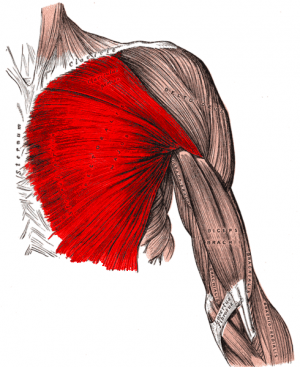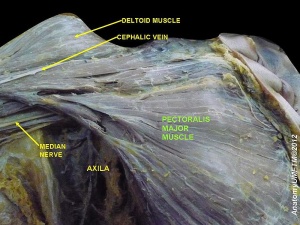Pectoralis major
Original Editor - Kudzanayi Ronald Muzenda
Top Contributors - Ilona Malkauskaite, Shaimaa Eldib, Kim Jackson, Lucinda hampton, Kudzanayi Ronald Muzenda, Pierre Beunardeau, Joao Costa, Wendy Walker, Oyemi Sillo, George Prudden and WikiSysop
Description[edit | edit source]
Anatomy[edit | edit source]
Origin[edit | edit source]
Origin of the upper fibers of pectoralis major is anterior surface of the sternal 1/2 of the clavicle. Anterior surface of the sternum, cartilages of first six or seven ribs and aponeurosis of the external oblique is the origin of the lower fibers of pectoralis major.[1]
Insertion[edit | edit source]
The upper and lower fibers of pectoralis major insert to the crest of greater tubercle of the humerus. Upper fibers are more anterior and caudal on the crest, while posterior fibers twist on themselves and are more posterior and cranial than the upper fibers.[1]
Nerve supply[edit | edit source]
Nerve supply to pectoralis major comes from brachial plexus.
Nerve of the upper fibers: Lateral pectoral nerve, C5,6,7.
Nerves to the lower fibers: Lateral and medial pectoral nerve, C6, 7,8, T1. [1]
Function[edit | edit source]
With the origin fixed, the pectoralis major adducts and medially rotates the humerus. With the insiortion fixed, it may assist in elevating thorax, as in forced inspiration. In cruntch-walking or parallel-bar work, it will assist in supporting the weight of the body. [1]
Clinical relevance[edit | edit source]
Weakness[edit | edit source]
Decrease the ability to draw the arm in horizontal adduction across the chest, making it difficult to touch the hand to the opposite shoulder. Decreases the strength of shoulder flexion and medial rotation.[1]
Shortness[edit | edit source]
The range of motion in horizontal abduction and lateral rotation of the shoulder is decreased. Shortness of the pectoralis holds the humerus in medial rotation and adduction and, secondarily, results in abduction of the scapula from the spine. [1]
Trigger Points[edit | edit source]
The trigger points in the pectoralis major muscle can produce symptoms that are nearly identical to the pain associated with having a heart attack or angina pectoris. Referred pain from these trigger points is experienced in the chest, front of the shoulder, down the inside of the arm, and along the inside of the elbow. They may also produce tenderness in the breast and nipple hypersensitivity.
Assessment[edit | edit source]
Palpation[edit | edit source]
Power[edit | edit source]
Length[edit | edit source]
Treatment[edit | edit source]
Resources[edit | edit source]








